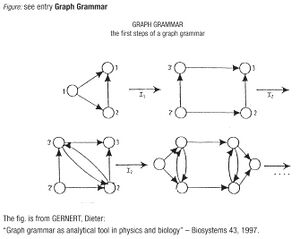GRAPH GRAMMAR
| Collection | International Encyclopedia of Systems and Cybernetics |
|---|---|
| Year | 2004 |
| Vol. (num.) | 2(1) |
| ID | ◀ 1461 ▶ |
| Object type | Discipline oriented, Methodology or model |

D. GERNERT proposed graph grammar as follows: “A mathematical technique which supports characteristic operations including the generation, transfer, recognition , interpretation and application of patterns ” (1997, p. 179)
Moreover “…parallel processes can be described by parallel graph grammars”(Ibid)
Gernert characterizes the basic patterns:
Pattern generation: the building up of a greater unit, not from elements , but from already existing building blocks
Pattern transfer: the duplication and insertion in different locations of an already existing pattern
Pattern recognition: an act of classification where a classification scheme has been previously defined
Pattern interpretation: an interpretation process of an existing pattern in a system that can influence the system's development
Pattern application: the triggering of a change of state by the transfer of a pattern to another location
As patterns are interrelations , it is possible to represent them by graphs. Complex graphs can be constructed step by step, using a “cellular graph automaton”, i.e. “an underlying graph where in each vertex an automaton equipped with an algorithm is installed”
Gernert gives an overview of the field (opened up by K. Zuse in 1975) which is developing steadily in theory and through applications in physics and biology.
See also
'figure next page'Artificial life, Game of life, Graph theory, Graph (transformation), Hora and Tempus parable, Hypercube, Network, Transfer function